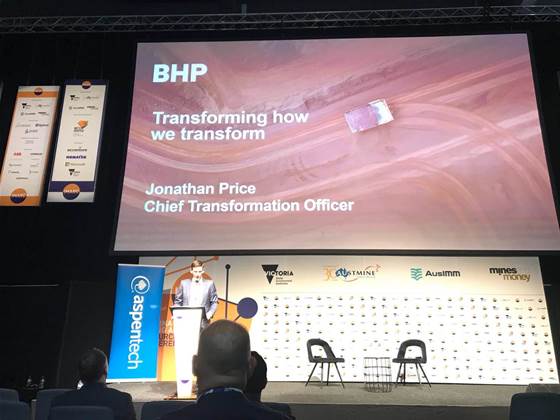BHP credits IT-led transformations for billions saved and years of productivity gains, but believes a “major new IT system” won’t help it transform once more.

Chief transformation officer Jonathan Price told the IMARC 2019 conference this week that he felt the miner needed to “change how we change”.
In doing so, he appeared to adopt the adage that ‘past performance is no guarantee of future results’: that is, what has worked for BHP to date would not guarantee its success into the future.
The opportunity for BHP is not about “changing the strategy, restructuring the company or rolling out a major new IT system,” he said, although in the past these had all been successful approaches to take.
Over the past five years, for example, Price said the company had created “a global operating model, leaving us with a small number of large, high-quality assets and a highly connected workforce” - and IT was a key enabler for that.
“Central to this is our enterprise-wide business operations system,” he said, which could be a reference to 1SAP, a massive transformation that standardised core processes and systems worldwide on SAP.
“It ensures transparency of vital data, whether you are in the Bowen Basin or the Gulf of Mexico.
“And our Yammer platform helps connect all our people so they can ask for help, link-up with subject matter experts or celebrate their successes.”
Price said the resulting “wave of productivity” that IT transformation had created “was great for us and great for our shareholders, delivering billions of dollars of benefits to our bottom line.”
But he thought “further gains are now harder won” in that space.
“The realisation has struck that the next wave of productivity will come in an entirely different form,” he said.
“As such, we can’t expect that what has worked in the past, will lead to success in the future.
“And so, to realise the full potential of our amazing orebodies, we must transform the way we have typically transformed.”
Technology would still play a role in that; Price noted the “fourth industrial revolution, with greater emphasis on connectivity through data, will build on this and have significant implications for the way we live, the way we work, and the way companies like BHP operate.”
“Our reliance on new technology will increase vastly,” he said.
But the company also needed to transform its “core”, Price said - and, in doing so, it needed to convince BHP’s workforce to change what they did at a deeper level than before.
He said that the company needed to give its people “the space to improve and innovate.”
“Of course we provide the appropriate training and tools, but the game changer here is inverting the typical leadership model: allowing our leaders to become coaches and empowering our frontline employees to take decisions and drive change,” Price said.
One of BHP’s challenges in driving this forward, however, is that the change may not be seen internally as particularly imperative.
“Many companies are forced to transform because of financial duress or an existential threat,” Price said, noting that BHP did not fall into this category.
“We start from a position of strength, not stress.
“As enviable as that sounds, it does make it harder to lift the activation energy of an organisation.”
Price also noted that BHP would have to convince the organisation that the next transformation would result in a different outcome to those in the past.
“Past programs have been and gone, and some of our people have seen this many times. So they question ‘what’s different this time around?’” Price said.
“The difference is that we will transform – meaning that we will create a new organisation and way of working from which there is no going back.
“We do this by building our future state into the fabric of BHP - our systems, structures, processes and routines - and supporting our people to build the skills and capabilities they need to be successful.
“This requires a holistic and coordinated effort coupling smart design with a relentless focus on implementation.
“Doing this well, drawing on a team of 72,000 people and the support of our partners and communities, we will make our changes stick.”


























